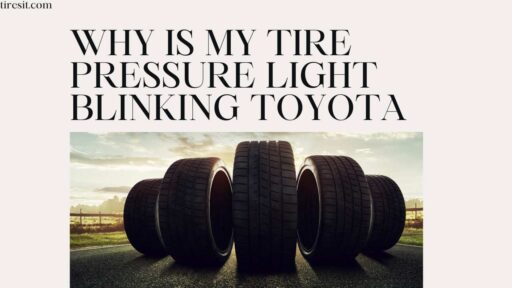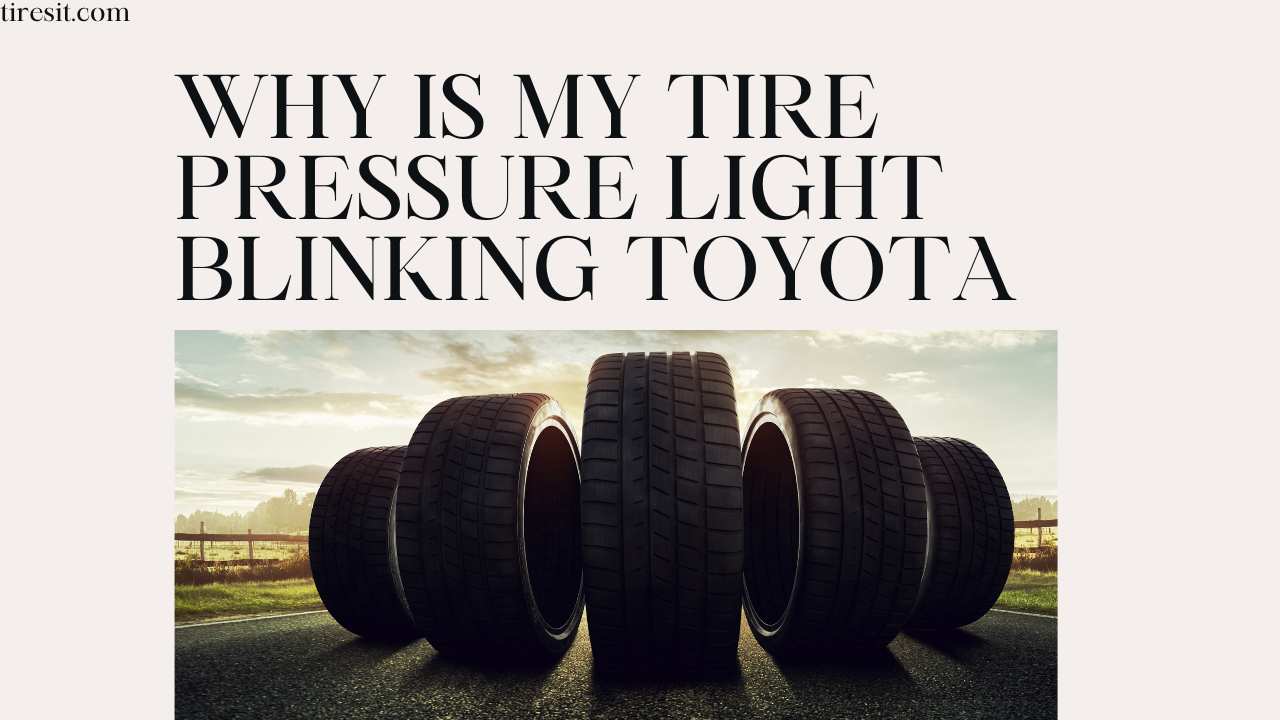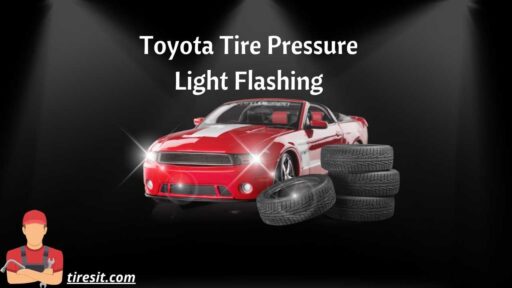Discover why is my tire pressure light blinking Toyota? light is blinking with our informative website. Get expert advice and troubleshooting tips to resolve the issue.
As a Toyota owner, you may have gone through the confusing experience of seeing your tire pressure light come on on your dashboard. This small but significant indicator can create confusion and worry for many drivers. This article will explain why your Toyota has a blinking tire pressure light and its importance unequivocally.
Understanding the why is my tire pressure light blinking Toyota?
Your Toyota’s tire pressure light acts as a vital safety feature that shows you when something goes wrong with your tires. Its major function is to monitor the amount of air inside each tire and alert you if there are extreme deviations from the recommended inflation level. With such an indication system installed, it is easier to ensure correct inflation levels for your tires; which are necessary for good fuel mileage, smooth driving, and safe highway transits.
The Necessity of Maintaining Tire Pressure
The significance of proper maintenance of tire pressure cannot be overemphasized. It is, however, very crucial as it determines safety, handling as well as fuel economy. However, this simple but important aspect of vehicle maintenance is ignored by many drivers who end up endangering their lives and reducing the performance of their vehicles.
Implications When The Warning Is Ignored
Can I drive with my warning sign on for some miles? Absolutely No! Depending on what one ignores about such warnings, there can be several possible outcomes with differing levels of dangerousness.
Results Of Driving With Incorrect Tire Pressure
- Decreased friction especially during harsh weather conditions that affect the effective braking or steering process
- Irregular tread wear causes reduced life span of the tires hence early replacement at high costs
- Increases rolling resistance due to under-inflated tires leading to poor fuel mileage by making it difficult for a car to move forward easily
Common Causes For A Toyota’s Tire Pressure Light To Blink
Low Tire Pressure: Causes and Solutions
One common reason why is my tire pressure light blinking Toyota? blinking is because there is low air pressure in the tires. Incorrect tire inflation can in turn reduce vehicle handling, and fuel economy and increase the risk of blowouts. Temperature changes, punctures, or just natural air seepage over time could lead to low tire pressure.
Check your owner’s manual or sticker inside the driver’s door jamb that will state the recommended tire pressure for your Toyota. A reliable tire pressure gauge should be used to measure the pressure of each tire, and then compare with the recommended value. Inflate all under-inflated tires using an air compressor or by following a guide from any nearby gas station or tire shop.
Tire Sensor Malfunction: Troubleshooting Tips
The blinking tire pressure light could also be a result of a malfunctioning sensor. These sensors monitor the air pressure in each tire and send this information to the car’s computer system. A bad sensor or one that is not working properly can cause the light on your dashboard to dashboard shine.
Troubleshoot a tire sensor malfunction by first visually examining each tire for any apparent damage or indications of leaking. When nothing strand looks can reset the tire pressure monitoring system by referring to your Toyota owner’s manual. If this fails, then it is better to visit an authorized Toyota service center where the sensors can be diagnosed and fixed professionally as necessary.
Tire Pressure Light On in Cold Weather
Cold weather conditions may also be responsible for lighting up the tire pressure light on your Toyota. As temperatures fall, the air inside your tires shrinks leading to a decline in tire pressure. Due to this natural phenomenon, blinking of the tire pressure light could occur requiring a little inflation of the tires.
During cold seasons, keep checking your tire pressures and inflate if recommended. However, it is important to note that over-inflating your tires is not advisable because it reduces traction leading to an increased risk of blowout.
Other Reasons Why Tire Pres Whey Light Blinks
While low tire pressure tire sensor malfunctions are common causes of blinking tire pressure lights in Toyotas; there are other reasons should be. They include damaged or missing valve stems, defective modules of the tire monitor system, or even a weak key fob battery.
If you have ruled out low air pressure and sensor issues on tires from triggering this warning sign on the dashboard your Toyota checked by certified mechanics would be recommended since they will help identify and fix other underlying problems causing such signal.
Why is Ra’s regular Tire Maintenance Important?
Properly maintained tires with correct inflation levels play a significant role in both the performance and safety aspects of any Toyota car model. This regular service routine prevents the flashing tire warning sign while extending the lifespan of tires as well as improving fuel consumption.
Further optimal maintenance guarantee requires you check once per month at least prior engaging in longer trips among others thus making sure that you have a working set. Also ensure that all four tires are inspected for damage which includes checking for any cracks, bulges and uneven tread wear. Immediate solutions are necessary in case of deviations to mitigate risks.
When You Ignore a Blinking Tire Pressure Light
Reduced Fuel Economy
Under-inflated tires increase rolling resistance, thereby requiring more energy to move the vehicle. This will decrease fuel efficiency, which would ultimately cost you the pump.
Poor Performance Handling
The handling of your vehicle can be compromised by low tire pressure. In particular, it can affect how your car responds during emergency emergencies on roads that have less friction. It may also make it hard for you to stop your car as quickly as you normally can when braking.
Tire Blowouts
Driving with under-inflated tires causes heat buildup and wears out faster than those with correct air pressure levels thus this makes them burst easily. This is much riskier especially at higher speeds or on tough terrain when compared to other types of faults that could occur on such a car.
Dealing with the Issue
Check Tire Pressure
Firstly check all four tires including the spare one manually by using a reliable r pressure gauge to confirm if they have inflated up to the man manufacturer the recommended pressure that can use a inside driver’s door jamb sticker or in own the ear’s mandate l. Look for damage
Carefully inspect the tires from a visual point of view for any damage signs such as punctures, cuts or bulges. These should be addressed immediately; however, if there is concern about their condition, it may be advisable to have them professionally inspected.
TPMS Reset
TPMS may need to be reset if tire pressure is at the correct level and no visible tire issues. Often this can be done through the vehicle’s onboard settings or following specific procedures in the owner’s manual.
Evaluation of Sensors
If the problem persists, you might want to consider having your tire pressure sensors examined by a qualified technician. They would identify any sensor-related issues that could necessitate sensor replacement or recalibration.
Professional Diagnostics
If troubleshooting at the user level doesn’t fix it suggests seeking help from a certified Toyota service center or automotive technician. They are equipped with specialized tools and have expert the is necessary for proper diagnostic evaluation that will address underlying TPMS or sensor-related issues.
Advantages of Maintaining Proper Tire Pressure
Investing time and effort into ensuring that tires are properly inflated yields several benefits:
Enhanced Fuel Economy and Performance
Correctly inflated tires can improve on gas mileage thereby saving you cash in return. Rightly so, they contribute to a smooth driving experience and improved vehicle handling.
Improved Safety on the Road
Properly filled tires mean better responsiveness during sudden maneuvers and shorter braking distances thus critical for safety purposes.
Longer Life Expectancy for Tires
By making sure that your tires wear out evenly, you will prolong their lifespan hence delaying replacements thereby keeping maintenance costs low.
How to Reset a Toyota Tire Pressure Light
Once you have solved the main issue resulting in the blinking of the tire pressure light in your Toyota car, resetting warning light may be needed. The procedure for resetting the tire pressure light may differ based on the model and year of your Toyota car. However, generally speaking you can follow these general steps to reset it:
Make sure that your tires are correctly inflated to the recommended pressure.
Turn on the ignition without starting the engine
Locate the tire pressure monitor reset button, usually located under the steering wheel or inside the glove box.
Press and hold down the reset button until you can see the tire pressure light blinking three times
Release your finger from the reset button and start your Toyota. The tire pressure light is now reset and should not be blinking again.
It is important to refer to your Toyota’s owner’s manual for specific information on how to reset a tire pressure light for a certain model and year.
Credit: proclaimliberty2000
FAQ
How do I know what my Toyota car recommended air pressures are?
You can find recommended air pressures for your Toyota car in most cases through manufacturers’ owner’s manuals or stickers attached to the driver door jamb. If you are not sure please consult with your dealer or a qualified mechanic.
Can I drive when the tire pressure light is flashing?
It is generally not advised to drive with a flashing tire pressure light, as this indicates that there may be an issue with your tires. Immediate attention to this matter is important for road safety reasons.
How often should I check my tire PSI?
Tire pressure checking should be done at least once in a month or before going on any long journey. Again, during regular maintenance, you should practice visually examining the tires for any signs of wear and tear.
Conclusion of why is my tire pressure light blinking Toyota?
In conclusion, never ignore the why is my tire pressure light blinking Toyota?. This is an important safety feature that helps to identify issues with your tires. If you understand the importance of tire pressure light, address common reasons behind its blinking as well as do regular tire service then you are assured of your Toyota’s comfort and safety while on the road. Always refer to your car owner’s manual regarding this matter and if necessary consult professional assistance on matters concerning your tire pressure light. Drive safely; keep informed!





